The Whole Brain® Model, developed by Ned Herrmann, serves as the cornerstone of the Herrmann Brain Dominance Instrument (HBDI®). The Whole Brain® Model outlines an array of thinking preferences centred around four distinct quadrants: Analytical (A), Practical (B), Relational (C), and Experimental (D).
Each of us has the ability to use all four quadrants, but we clearly have preferences for some over others. Unveiling the intricacies of each quadrant can empower individuals to better understand their thinking preferences and enhance communication, both personally and within teams.
Understanding the Whole Brain® Model
What is the concept behind Ned Herrmann’s Whole Brain® Quadrants?
Ned Herrmann, the visionary behind Whole Brain® Thinking, is considered ‘the father of cognitive style technology’ after he devised the model that categorises thinking styles into four key quadrants. While everyone possesses the ability to think in each of these quadrants, individuals tend to have a preferred thinking style for one or more quadrants. This is arguably the most crucial concept explored through the HBDI®.
The Whole Brain® quadrants are based on different thinking styles that we all possess. These quadrants are equally important, and our preferences within them allow us to better understand our own thinking processes, habits, and strengths.
The Interconnectedness of Our Brains
Some people believe that each side of our brain is responsible for specific cognitive functions. However, this popular narrative fails to account for the complex interconnectedness of our brain hemispheres.
In reality, our brains operate as a whole, with each hemisphere working together to provide a complete picture of our reality. Even when we have preferences for specific thinking quadrants or styles, various areas of our brain are wired to collaborate with other areas of specialisation. The Whole Brain® Quadrants are a metaphorical description of our thinking preferences, not a physical division of our brain hemispheres. It conceptualises the thinking processes of our brain rather than the fundamental and intricate operation of the brain as a whole.
Exploring the Four Quadrants of the Whole Brain® Model
The four quadrants of the Whole Brain® Model provide a framework for understanding our thinking styles. Understanding our preferred thinking style within each of these quadrants can help us recognise our cognitive opportunities and challenges, and ultimately help us become more effective in our personal and professional lives.
The A Quadrant (Analytical)
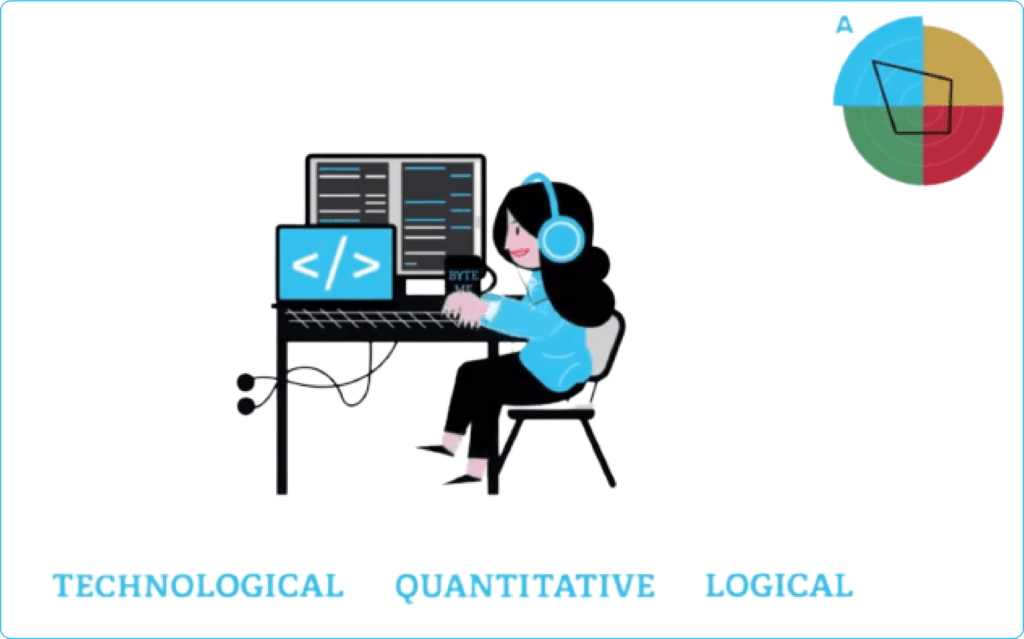
The Upper Left Blue A Quadrant is characterised by its specialisation in logical, analytical, quantitative, and fact-based thinking processes. Individuals with a preference for Analytical thinking are aided by the characteristics and thinking processes that define this quadrant, as they excel in problem-solving and decision-making tasks.
Whether they are financial analysts who adeptly analyse complicated data or researchers who rigorously seek out evidence-based solutions, analytical thinkers thrive in the Upper Left Blue A Quadrant.
By drawing on their strengths in logical and analytical thinking, people with a preference for this thinking style are able to solve complex problems and make sound decisions with ease.
A Quadrant: Thinking Preference Example
Josh, an analyst at a financial company, often works in the Upper Left Blue A Quadrant. He spends his days poring over spreadsheet after spreadsheet, analysing complicated financial data to help make informed decisions about which investments to pursue. He relies heavily on his quantitative skills to identify patterns and trends in the numbers, and uses logical thinking to make recommendations to his colleagues. Josh’s analytical thinking style allows him to provide valuable insights and solve complex problems in his industry.
Quadrant B (Practical)

The Lower Left Green B Quadrant is where attention to detail, planning, organising, and sequencing information are at the forefront. For individuals with a preference for the ‘practical’ quadrant, this thinking style allows them to contribute structured and organised approaches to different aspects of life.
Whether it’s a project manager planning out the timeline and financial aspects of a complex work assignment or a homemaker creating a daily routine for their family, the practical thinking style of the Lower Left Green B Quadrant helps individuals to break down tasks into manageable components.
By meticulously planning and organising information, individuals are able to bring structure and clarity to complex situations. Those with an affinity for this style of thinking are invaluable assets to teams, as they provide structure and order to even the most complicated of projects.
B Quadrant: Thinking Preference Example
Samantha works as an event planner, and she draws heavily from the Lower Left Green B Quadrant during her day-to-day work. She has to coordinate many different elements of an event, from booking the venue to arranging catering to ensuring that all the necessary supplies and equipment are available. Samantha’s practical thinking style allows her to break down the event into small, manageable pieces, and she uses her excellent planning and organising skills to create a detailed timeline for each aspect. By sequencing the information and creating a clear plan for each step of the event, Samantha is able to pull off successful events time and time again.
Quadrant C (Relational)

The Lower Right Red C Quadrant is where feelings and interpersonal relationships take centre stage. This thinking style prioritises emotions and kinesthetic elements, making it a natural fit for people with a preference for relational thinking. Those who tend to think in terms of relational aspects find harmonious relationships and effective communication as essential components of their lives.
Whether they are customer service representatives empathetically handling a customer’s complaint or couples’ therapists guiding partners to a better understanding of each other, relational thinkers excel in facilitating meaningful connections with others.
By drawing on their strengths in emotional intelligence and kinesthetic awareness, individuals with a preference for this thinking style are able to navigate complex social dynamics with ease and contribute to harmonious relationships.
C Quadrant: Thinking Preference Example
As a nurse, Lisa often works within the Lower Right Red C Quadrant. She needs to provide care and support to patients who may be anxious, fearful, or in pain, and she relies heavily on her empathetic thinking style to connect with them. Lisa prioritises understanding her patients’ emotional needs and works to create a warm and supportive environment. She is skilled at active listening and able to communicate clearly and compassionately with both her patients and their families. Lisa’s relational thinking allows her to form deep connections with her patients and provide effective care that addresses their emotional, as well as physical needs.
Quadrant D (Experimental)

The Upper Right Yellow D Quadrant is where synthesising and integrating information takes a holistic and intuitive approach. This thinking style is known for its ability to come up with unique ideas and creative solutions to problems.
Individuals with a preference for experimental thinking thrive in the Upper Right Yellow D Quadrant, where they are able to draw connections between seemingly unrelated concepts to create novel solutions. Whether they are artists working on new projects, innovation consultants coming up with new business models, or engineers prototyping new products, experimental thinkers are masters of synthesis and innovation.
By drawing on their strengths in intuition and an ability to see connections where others cannot, they are able to create breakthrough ideas that challenge traditional ways of thinking and propel industries forward. Their creativity and unorthodox approaches to problem-solving help break down barriers and make room for progress.
D Quadrant: Thinking Preference Example
As a product designer, Alex spends much of his time in the Upper Right Yellow D Quadrant. He is always looking for new and innovative ways to solve design problems and create products that are unique and useful. Alex draws on his experimental thinking style to approach challenges from different angles, combining his knowledge of emerging technologies with his intuitive sense of what people need and want. He often comes up with “out-of-the-box” ideas that help him design products that stand out from the competition. By synthesising and integrating information from different sources, Alex is able to create novel solutions that meet the needs of his clients and delight their customers.
Communicating with Different Thinkers and Thinking Preferences
In order to effectively communicate with others, it’s important to consider their preferred thinking style and tailor your approach as needed. Here are some strategies for communicating with each of the four Whole Brain® Quadrants.
Download our full guide for communicating with different thinkers here.

How to Tailor Communication to Analytical Thinkers (Quadrant A)
Analytical thinkers thrive on logic and facts, and tend to approach problems with a rational mindset. To communicate effectively with individuals who prefer Analytical thinking, consider the following strategies:
- Focus on presenting clear evidence and rational arguments
- Use data and numbers to support your ideas
- Be prepared to answer detailed questions or provide additional information if requested
- Avoid overly emotional or subjective language
- Provide structured and organised information in a clear and concise manner
- Highlight the logical and practical benefits of your ideas
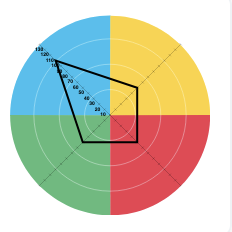
For example, if you are presenting a proposal to an analytical thinker, you might want to provide them with a detailed report that includes data and charts to support your idea, rather than relying on flashy visuals or emotional appeals.
How to Adapt your Communication for Practical Thinkers (Quadrant B)
Individuals who prefer Practical thinking are focused on details, planning, and organisation. To communicate effectively with them, consider the following strategies:
- Highlight the practical benefits of your ideas, such as increased efficiency or productivity
- Provide clear guidelines and expectations for tasks or projects
- Use concrete and specific examples to illustrate your points
- Avoid abstract or theoretical discussions
- Provide plenty of detail and be prepared to answer specific questions
- Provide clear timelines and deadlines
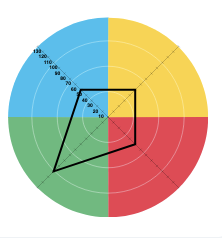
For example, if you are working with a practical thinker on a project, you might want to break down the project into specific tasks and provide them with a detailed timeline for each step, along with clear instructions for completing each task.
How to Navigate Communication with Relational Thinkers (Quadrant C)
Individuals with a preference for Relational thinking value emotional connections and interpersonal relationships. To communicate effectively with them, consider the following strategies:
- Take the time to establish a personal connection
- Use emotional language and appeal to their empathy
- Be prepared to provide emotional support and validation
- Use stories and anecdotes to illustrate your points
- Be aware of nonverbal cues and body language
- Listen actively and build interpersonal connections
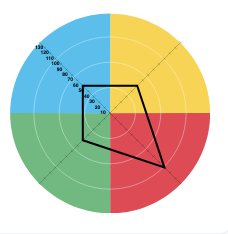
For example, if you are working with a relational thinker, you might want to start by asking about their day or something personal, showing that you value their connection to you as a co-worker or client. You might also soft-pedal criticism with a “sandwich” technique, in which you deliver negative feedback between two positive comments.
How to Engage in Effective Communication with Experimental Thinkers (Quadrant D)
Experimental thinkers are creative and open-minded, often coming up with innovative ideas and solutions. To communicate effectively with individuals who prefer Experimental thinking, consider the following strategies:
- Encourage brainstorming and out-of-the-box thinking
- Use creative language and imagery
- Be willing to take risks and try new approaches
- Use metaphors and symbolism to illustrate your points
- Emphasise the potential impact or significance of your ideas
- Be open to change and willing to adapt
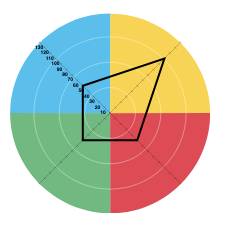
For example, if you are working with an experimental thinker, you might want to encourage them to explore different ideas and approaches, brainstorming outlandish possibilities without concern for whether they are feasible in the real world. You might also appeal to their imagination and their sense of adventure, painting a bold picture of the potential impact of their ideas.
Implementing Four-Quadrant Thinking into Your Life and Work
The journey through the four thinking quadrants of the Whole Brain® Model can help individuals make sense of their preferred thinking styles and how to better communicate with those who favour different styles. By recognising our own thinking preferences and how they fit into the Whole Brain® Model, we can better understand our strengths, work more effectively with others, and approach problems in new and innovative ways.
What if someone has preference for more than one Quadrant?
In reality much of the population draws upon more than one thinking quadrant. You can use the HBDI to decode the preferences of others to best tailor and target your message. Look at the two examples below to consider how you can use the suggestions above to more effectively tailor your message:
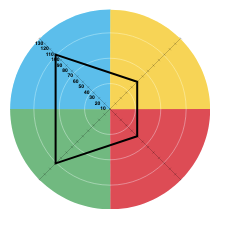
This Thinker draws upon the analytical and practical thinking quadrants together. The communication approach would require a focus on both the A and B quadrants styles and tips. This profile represents 18.92% of the Herrmann Database.

This Thinker draws upon the practical, relational and experimental thinking quadrants. The communication approach would require a focus on the B, C and D quadrants. This preference pattern represents 10.25% of the Herrmann database.
Communication plays a crucial role in this process, with tailored approaches to engage with individuals who have different quadrant preferences. By embracing the Whole Brain® Model and its Quadrants, we can unlock our full thinking potential and grow both personally and professionally.
If you want to learn more about how Whole Brain® Thinking and the HBDI® can help you and your organisation, have a look at how it works here or get in touch and we’ll help you find the right solution.


